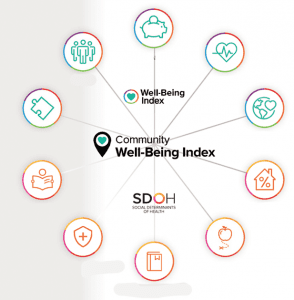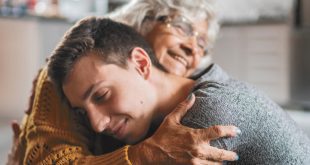By Blue Zones Project Southwest Florida
 Many of us have heard the expression that the “whole is greater than the sum of its parts.” This is especially true when it comes to community health and well-being. There are multiple key factors that drive well-being that not only impact each individual, but also determines how much an entire community thrives. Ten years ago, Sharecare, parent company of Blue Zones Project, pioneered the concept of well-being, inspired by the WHO definition of health as a “state of complete physical, mental and social well-being and not merely the absence of disease and infirmity.”
Many of us have heard the expression that the “whole is greater than the sum of its parts.” This is especially true when it comes to community health and well-being. There are multiple key factors that drive well-being that not only impact each individual, but also determines how much an entire community thrives. Ten years ago, Sharecare, parent company of Blue Zones Project, pioneered the concept of well-being, inspired by the WHO definition of health as a “state of complete physical, mental and social well-being and not merely the absence of disease and infirmity.”
This well-being concept is measured on 5 different constructs:
• Purpose – Liking what you do each day and being motivated to achieve your goals
• Social – Having supportive relationships and love in your life
• Financial – Managing your economic life to reduce stress and increase security
• Community – Liking where you live, feeling safe and having pride in your community
• Physical – Having good health and enough energy to get things done daily
Combined, these elements make up the Well-Being Index (WBI), and have been used to measure community well-being for more than a decade.
Most recently, these measurements have been expanded to include Social Determinants of Health (SDOH). The SDOH measure Economic Security, Healthcare Access, Resource Access, Food Access, and Housing & Transportation. More than 600 data points are collected from these and examined by Boston University to help form valid and reliable predictors of well-being.
For the first time ever in Southwest Florida, SDOH and the WBI have been combined to measure well-being under a comprehensive assessment known as the Community Well-Being Index (CWBI). This in-depth measurement even provides real-time feedback.
Much like a car that requires a diagnostic instrument to be plugged in to measure how well it is running and isolate any problems, Sharecare and Blue Zones Project use the RealAge® test as a collection instrument to determine how well Southwest Florida measures in well-being, and uncovers opportunities for improvement. Taken by over 43 million people worldwide, the RealAge test determines how old a person really is based on stress levels, diet, activity, and sleep. Then, goals are set to lower or maintain that person’s RealAge.
For Southwest Florida, RealAge data was collected in 2020-21 within seven community subsets (Bonita Springs, Estero, Naples, Golden Gate, East Naples, Immokalee, and Marco Island). Results show that Southwest Florida’s latest overall well-being score—72.2 out of 100—compares favorably to the most recent state and national data, at 64.0 and 64.3.
In comparison data from 2015 (the year Blue Zones Project Southwest Florida began), results show many more people are thriving in Southwest Florida, and healthy behaviors are on the rise. Highlights include:
• Nearly 70 percent of respondents are exercising at least 30 minutes a day, 3 days a week, a rise of 11.7 percentage points since program launch.
• Tobacco use dropped by 5.2 percentage points, reaching an impressive low of 3.6 percent in 2021.
• A stronger sense of purpose is fueling well-being, with more people reporting they like what they do and that they learn or do something interesting every day.
• More residents are feeling recognized for helping improve the area where they live—a jump of 13 percentage points and a boost to community well-being.
• Naples, East Naples, and Golden Gate Estates saw statistically significant improvements in overall well-being and in two or more well-being elements. Physical well-being showed statistically significant improvements in Bonita Springs and Estero, and purpose well-being rose measurably on Marco Island.
• Research supports positive to no impact on lifestyle behaviors for most populations during the pandemic. Unexpected improvements in some health measures such as blood pressure may be affected by an absence of data due to people postponing healthcare visits during the pandemic.
While there have been great improvements in overall reduction of certain health risks in Southwest Florida, certain opportunities for improvement remain according to the CWBI data. Stress affected 78.6 percent of respondents in 2020-21; a lack of exercise with weights, 65.2 percent; inadequate fruit and vegetable consumption, 61.4 percent; and high Body Mass Index, 54.7 percent.
Also, 2015 – 2018 data on SDOH showed Southwest Florida scoring well above comparable communities on most measures but lagging the state on some aspects of healthcare and food access. Healthy food access within one mile is a challenge for 48.72 percent of the region’s population and affects many demographic groups.
Ongoing action to support well-being through tangible, environmental changes will further improve these measures. Areas for continued focus include:
• Expanding access to healthy food
• Raising fruit and vegetable consumption
• Increasing active commuting: walking, biking, and the use of public transit
Blue Zones Project Southwest Florida continues to harness the power of “we” by working with over 780 organizations to include worksites, schools, restaurants, HOA’s, faith-based organizations and other organizations. By continued collection and measurement of well-being data, Blue Zones Project and our many partners can continue to move the needle in a positive way and allow the determination of where resources are most needed. We invite individuals and organizations to use the RealAge tool by visiting bzpsouthwestflorida.sharecare.com.
Brought to Southwest Florida by NCH Healthcare System, in collaboration with Sharecare, Inc., Blue Zones Project is part of Southwest Florida’s well-being improvement initiative that encourages changes in the community that lead to healthier options. For more information, visit southwestflorida.bluezonesproject.com.
 Southwest Florida's Health and Wellness Magazine Health and Wellness Articles
Southwest Florida's Health and Wellness Magazine Health and Wellness Articles

